
The distribution of dissolved aluminium in the West Atlantic Ocean shows a mirror image with that of dissolved silicic acid, hinting at intricate interactions between the ocean cycling of Al and Si. The marine biogeochemistry of Al is of interest because of its potential impact on diatom opal remineralisation, hence Si availability. Furthermore, the dissolved Al concentration at the surface ocean has been used as a tracer for dust input, dust being the most important source of the bio-essential trace element iron to the ocean. Previously, the dissolved concentration of Al was simulated reasonably well with only a dust source, and scavenging by adsorption on settling biogenic debris as the only removal process. Here we explore the impacts of (i) a sediment source of Al in the Northern Hemisphere (especially north of ~40°N), (ii) the imposed velocity field, and (iii) biological incorporation of Al on the modelled Al distribution in the ocean. The sediment source clearly improves the model results, and using a different velocity field shows the importance of advection on the simulated Al distribution. Biological incorporation appears to be a potentially important removal process. However, conclusive independent data to constrain the Al/Si incorporation ratio by growing diatoms are missing. Therefore, this study does not provide a definitive answer to the question of the relative importance of Al removal by incorporation compared to removal by adsorptive scavenging.
MMP van Hulten, A Sterl, R Middag, HJW de Baar, M Gehlen, JC Dutay, A Tagliabue. On the effects of circulation, sediment resuspension and biological incorporation by diatoms in an ocean model of aluminium
Status: published, Journal: Biogeosciences, Volume: 11, Year: 2014, First page: 3757, Last page: 3779, doi: 10.5194/bg-11-3757-2014